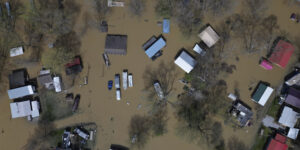States hit hardest by recent Midwest flooding — including Missouri, Iowa, Kansas and South Dakota — generally have National Flood Insurance Program (NFIP) insured rates of less than 1 percent, another reminder of the massive insured “protection gap” in the United States and the ineffectiveness of the current flood program, A.M. Best said in recent commentary.
Plus, federal flood maps are outdated in many cases, so it is likely that prospective insureds did not have a true idea of their susceptibility to potential flood losses, AM Best pointed out.
Best’s commentary, “Blizzards, Heavy Rains and Melting Ice Produce Catastrophic Midwest Flooding,” also notes that early published estimates of damage to infrastructure, private property and agriculture have exceeded $1 billion and have since been increased to as much as $3 billion, with that figure expected to increase even further.
National and multinational insurers whose portfolios are diversified geographically should not be subject to losses that result in pressure on their capitalization, therefore A.M. Best does not expect rating pressure on those carriers.
Smaller, single state or regionally focused insurers whose portfolios feature a concentration of risks in the affected states, however, could suffer proportionately larger losses. Less diversified companies could be affected materially, not only from a profit and loss perspective but in terms of balance sheet strength as well.
While property/casualty insurers will bear the cost of certain claims — submerged automobiles, lost livestock (cattle) and damages to heavy farm equipment — the vast majority of the damage to homes and personal property is expected to be uninsured. In all likelihood, the damage costs will again be absorbed by residents and business owners, with state and local authorities likely bearing a portion of the cost to rebuild communities.
Flood losses to business and vehicles, including business interruption claims, will likely generate the lion’s share of the insurable losses from the storms. Losses to onshore commercial and industrial properties and their contents, along with insured commercial automobiles, are expected to be substantial, especially for companies with geographic concentrations in the affected states. Business interruption claims for commercial enterprises and, to a lesser extent, additional living expenses for covered residential property owners could also drive up the loss total for which primary insurance companies and their reinsurers will be liable.
Source: A.M. Best
*A version of this story appeared previously in our sister publication Insurance Journal.





















 HOA Secures $2.5M ‘Wildfire Resilience Insurance’: WTW
HOA Secures $2.5M ‘Wildfire Resilience Insurance’: WTW  Allstate: How Can You Save on Auto Insurance?
Allstate: How Can You Save on Auto Insurance?  Buyer-Friendly April Reinsurance Renewal Bodes Well for Mid-Year Renewals: Brokers
Buyer-Friendly April Reinsurance Renewal Bodes Well for Mid-Year Renewals: Brokers  The Workplace Is Changing; So Are the Risks for Employment Discrimination Claims
The Workplace Is Changing; So Are the Risks for Employment Discrimination Claims 











